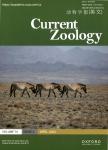Taste responsiveness to two steviol glycosides in three species of nonhuman primates
Taste responsiveness to two steviol glycosides in three species of nonhuman primates作者机构:IFM Biology Linkoping University Linkoping SE-581 83 Kolmarden Wildlife Park Kolmarden SE-681 92 Boras Zoo Boras SE-501 13 Sweden Instituto de Neuro-Etologia Universidad Veracruzana Xalapa Veracruz C.P. 91000 Mexico
出 版 物:《Current Zoology》 (动物学报(英文版))
年 卷 期:2018年第64卷第1期
页 面:63-68页
核心收录:
学科分类:0710[理学-生物学] 0832[工学-食品科学与工程(可授工学、农学学位)] 07[理学] 08[工学] 071002[理学-动物学]
主 题:品尝 植物种类 应答 人类 进化历史 持续时间 味道 公里
摘 要:Primates have been found to differ widely in their taste perception and studies suggest that a co-evolution between plant species bearing a certain taste substance and primate species feeding on these plants may contribute to such between-species differences. Considering that only platyrrhine primates, but not catarrhine or prosimian primates, share an evolutionary history with the neotropical plant , we assessed whether members of these three primate taxa differ in their ability to perceive and/or in their sensitivity to its two quantitatively predominant sweet-tasting substances. We found that not only neotropical black-handed spider monkeys, but also paleotropical black-and-white ruffed lemurs and Western chimpanzees are clearly able to perceive stevioside and rebaudioside A. Using a two-bottle preference test of short duration, we found that preferred concentrations as low as 0.05 mM stevioside and 0.01 mM rebaudioside A over tap water. Taste preference thresholds of were similar to those of the spider monkeys, with 0.05 mM for stevioside and 0.03 mM for rebaudioside A, whereas was slightly less sensitive with a threshold value of 0.1 mM for both substances. Thus, all three primate species are, similar to human subjects, clearly more sensitive to both steviol glycosides compared to sucrose. Only the spider monkeys displayed concentration-response curves with both stevioside and rebaudioside A which can best be described as an inverted U-shaped function suggesting that , similar to human subjects, may perceive a bitter side taste at higher concentrations of these substances. Taken together, the results of the present study do not support the notion that a co-evolution between plant and primate species may account for between-species differences in taste perception of steviol glycosides.



